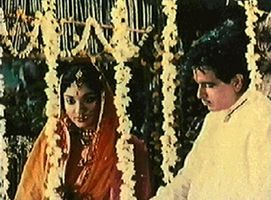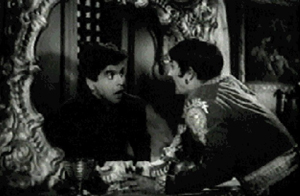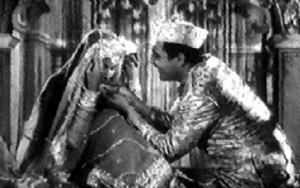It is rather strange, even disorientating, for a person like me who began his mid-career in the 60s, to look back at that period. People of my generation, who were the first young adults of Independence, did not find freedom a dawn in which it was bliss to be alive. But the 50s was a period of Pax Nehruviana - the Nehruvian peace. It was a period, to quote Chidananda Dasgupta, of the continuance of the Gandhi-Tagore-Nehru consensus. This consensus was reflected in the popular cinema of the period. Except for the dissident voices of Bimal Roy and Guru Dutt (their dissidence sprang from very different sources) most of the other prominent filmmakers accepted the Nehruvian peace. This acceptance was most prominent in the frame-work of Mother lndia (the first and last sequences) but was also implicit in Awaara and Shree 420.
Nehruvian socialism and our preeminence in the non-aligned movement fed illusions of social justice at home and a special place in intemational relations. The Indo-Chinese War of 1962 was a massive jolt to the national ego. It also set our economic development back by at least a dozen years. Rural feudalism had not been eliminated and the income gap between various sections of population - both rural and urban - was increasing. The Nehruvian peace began to be seen by the more discerning for what it really was - a middle class holding together operation in a subcontinent with a maze of religions, a babble of tongues and most important of all, with a debasing poverty of nearly half the population.
Clearly it was time for cinema, as for other arts, "to begin an ideological debate with the culture that bred them." Such a debate had begun in Bengali cinema - both with regard to content and style - in the works of Ray, Ghatak and Mrinal Sen. In Hindi cinema it began only with first flickerings of New Cinema late in the 60s with Mrinal Sen's Bhuvan Shome (1969) and Mani Kaul's Uski roti (1969).
 |
Gangā Jamnā (1961) |
Still, the Indian reality could not be ignored by popular cinema. I do not mean to say popular cinema examined it in any deliberate fashion. Muslim socials, comedies and emotional dramas continued to be made and they will be briefly examined. Yet in
Guide (1965),
Ganga Jumna (1961),
Teesri Kasam (1966) and in
Satyakam (1969) and other films of Hrishikesh Mukherjee, various dilemmas, agonies and tragedies of the Indian crisis surfaced in different styles and forms. The two quotations given at the head of this article give opposing visions of the India of 60s. As reflected in cinema these visions bestow on it a special fascination, a special significance. In a sense some of these films (
Guide, for instance) made a separate truce with the difficult and disillusioning reality of the 60s. Perhaps they were not satisfactory truces. But their echoes continue to reverberate in the 80s cinema. Other films commenced 'battles' - for instance
Ganga Jumna and
Satyakam - which too continue to this day.
 |
Koh-e-nūr (1960) |
The 'entertainment' films (which include tragic melodrama) of the 60s moved in well established grooves.
Kohinoor (1960) for instance, starring Dilip Kumar and Meena Kumari, combined the comic tradition of the film
Azad (1955) - same team - mixing it with the
panache of the Madras Gemini Studios' film
Chandralekha (1948). For scholars pursuing the subject of themes and variations in popular cinema, I offer a gem: There is a comic scene in
Kohinoor where Dilip Kumar fools Jeevan into thinking they are mirror images (itself lifted from a Hollywood film) which is duplicated by Amitabh in
Mard (1985).
To illustrate the variety of 1960s entertainment let me take three films - Mere Mehboob (1963), Dil Ek Mandir (1963), and Dil Tera Deewana (1967).
Of these the most important is, of course, Mere Mehboob. It is not only the quintessential Muslim Social in cinema's history, it is also its most typical entertainer. Basically the following elements have gone into its making: Creation of an ambience, now lost, which looked backward nostalgically. It would be wrong to call it Muslim. Rather it is Lucknawi - which usually contains an obligatory Hindu character, in this film the poet Rastogi (Johnny Walker). Despite its extravagance in music, dance and colour, the decadence of Muslim society is evident in the film. However you will not see a single destitute or poor Muslim. The Muslim family is going downhill but will be saved just before reaching the Lower Depths. Despite the final miracle, films like Mere Mehboob reflect actual decline and this element of poignance becomes yet another attraction of such films.
The story belongs to the Laila Majnu genre though the Radha Krishna element comes in by way of songs and dances. A young man and a woman at Aligarh University fall in love. But unlike the earlier Laila Majnu tradition in which frank love developed openly, a Muslim social is based on the concept of jhalak - glimpse. Because of the purdah system, only a fleeting glimpse (allowed by a briefly uplifted veil) is available to the lover. Sherwani-clad Rajendra Kumar thus falls in love with burqaed Sadhana. But while burqa unites, it can also divide because of its fortuitous behaviour. It leads to mistaken identity and Ameeta too falls in love with Rajendra Kumar - with tragic (but not fatal as is usual) consequences.
 |
Chaudahvīn kā chānd (1960) |
Guru Dutt's
Chaudhvin Ka Chand basically follows the same pattern (its original title was
Jhalak) though the situations are reversed.
I think this notion of Jhalak in Muslim socials needs to be worked out by students of popular cinema. Its mixture of chance, nostalgia, mysticism (in the sense of transcending a continuous sexual charge) and a certain black ruthless destiny which is intertwined with romantic love, has held audiences in the trashiest of Muslim socials.
One other element is the song and dance. Sahir Ludhianvi, the famous lyricist, once published a collection of his film songs called Gata Jaye Banjara [Continui a cantare lo zingaro]. The title is significant, hinting at the gypsy like character of film poetry. A trifle apologetically Sahir pleaded for recognition of film songs as poetry. Sahir's film lyrics are in a class by themselves. But even Shakeel Badayuni's songs in this film - ornate as they are (set to tender music by Naushad) - qualify, I think, as the best of popular poetry. Today's film songs have little relevance to the situations. In Mere Mehboob the songs heighten the mood and make a most contrived situation haunting. An excellent example is the song where heartbroken Ameeta 'gives away' Rajendra Kumar to Sadhana. In a way this is the high point of happy romanticism (tears and laughter) of Indian cinema which can be set against the black romanticism of Pyaasa - and even to an extent of Chaudhvin Ka Chand.
Dil Ek Mandir (Director: Sridhar) if released today would perhaps cause apoplexy among some critics. But if one looks beyond its exploitative sentimentalism and its vulgar drama, one can isolate elements in it which reappear in 80s films like Thodhi Si Bewafaai, Ghar Sansar and very recently Sindoor. Dil Ek Mandir is one of the prototypes.It really is a mythological film in a modern garb. Hence its power. Two of the three main characters - husband and wife - are called Ram and Sita. The third character is a doctor played by Rajendra Kumar. The doctor was formerly romantically involved with Sita. Now when Ram comes to his clinic with terminal cancer the doctor is faced with a dilemma (not unlike the Shavian dilemma but couched in traditional Indian terms). The way the dilemma is resolved is near farcical - it ends with the doctor's death after his successful operation on Ram.
As in Mere Mehboob, certain standard elements have been used. The first is the figure of Meena Kumari who perhaps more than any other actress embodied all the hopes, frustrations, subliminal longings, suppressed sexual passion and the drive to self destruction of the traditional middle class Indian woman, both in her life and art. She veered between the much mocked but still vital Sati Savitri image and the desirable bride image, an extension of which was the respectable courtesan image. Here, with a dying husband and a former worshipper to torment her, she is Sati Savitri who becomes a bride the night before Ram's operation. This appears bizarre till one remembers the I link between Eros and Thanatos - love I and death - which haunts films like Abrar Alvi's Saheb Bibi aur Ghulam and Mahesh Bhatt's recent Kaash. The whole complex of images is summed up in the song "Ham tere pyar mein sara alam kho baithe" [Nel tuo amore ho perduto tutto il mondo]. At one level this song may appear as the trite emotional expression of a sacrificial psyche. At another level it is the very outpouring of a personality submerged by the demands made on love and devotion of an Indian wife.
At such moments the Indian film song goes beyond its mediocre frame and demands to be treated in its own right as a genuine cultural product.
Dil Ek Mandir in other moments is an uninspired middle class fable. The typical 50s and 60s high sentiments dominate the film. A typical shot is of Meena in white in a mirror, saying Aadarsh ke pavitra ganga ke saath chaloongi [Camminerò avendo come specchio ideale la sacra Ganga]. That scene sums up the noble mediocrity of the 60s cinema which has been revived in one kind of Jeetendra-Jaya Prada-Sridevi family starrers in the 80s.
Dil Tera Deewana is as typical of the 60s as the other two serious films discussed above. This is a comedy film - but we have descended a long way from Mr. and Mrs. 55. Shammi Kapoor is as much a period figure as Meena Kumari. But he has evolved out of Hollywood slapstick and native low tamasha. Dil Tera Deewana is a comedy of errors revolving around a zany played by Shammi Kapoor and his lover played by Mala Sinha. Low comedy is provided by Mehmood.
As comedy, Dil Tera Deewana is interesting both for its successes and failures. It succeeded in creating a fast and giving him a rather amusing script. It also succeeded in providing the hero with perfect, light songs: Mujhe kitna pyaar hai tumse [Quanto ti amo]. It failed in not providing a sustained situational comedy, or a script of quality.
Note
Lailā-Majnūn: racconto popolare di origine araba che narra la tragica storia d'amore tra la bellissima Lailā e il giovane Qais, ostacolata dal padre di lei che costringe Lailā a sposare un altro, Ibn Salām. Lailā rifiuta di consumare le nozze e lo sposo, che l'ama, rispetta la sua volontà. Ibn Salām muore e poco dopo muore anche Lailā. Quando Qais, che nel frattempo è impazzito per amore (diventando Majnūn o "Folle"), apprende della morte dell'amata, muore a sua volta sulla sua tomba.
Rādhā-Krishna: vicenda amorosa di Krishna, eroe della mitologia hindu, considerato l'ottava incarnazione del dio Vishnu (probabilmente di origini non arie; è raffigurato di colore blu e il suo nome significa "nero"), e di Rādhā, moglie del pastore Ayanghosh. Rādhā, talora considerata incarnazione di Lakshmī, consorte di Vishnu, rappresenta secondo alcune interpretazioni l'anima umana attirata verso dio o come il il puro divino amore a cui l'incostante innamorato sempre ritorna.
Purdah = pardā: "cortina", "schermo", "velo", soprattutto per celare la vista delle donne allo sguardo di uomini estranei alla famiglia; per estensione, la condizione di isolamento delle donne musulmane, ma anche hindu di casta alta.
Shervānī: tipica giacca musulmana, lunga e attillata.
Burqā: "velo", "mantello", il copriabito, che copre anche il viso, indossato dalle donne usulmane per uscire in pubblico.
Rām-Sītā: rapporto che lega Rām, eroe del poema epico Rāmāyan e considerato la settima incarnazione di Vishnu, alla sposa Sītā, la pativratā per eccellenza della tradizione hindu, ovvero l'ideale di assoluta e costante devozione femminile allo sposo (patī), considerato un dio (dev), quale che sia il suo comportamento.
Satī Sāvitrī: personaggi della mitologia hindu che incarnano modelli di sposa ideale. Satī, figlia di Daksha (figlio di Brahmā) è la sposa del dio Shiv, immolatasi sulla pira per un'offesa recata dal padre allo sposo. Sāvitrī, figlia del re Ashvapati, sposa Satyavān pur sapendo che sarebbe morto dopo un anno; quando arriva Yam, il dio dei morti, a prendere l'anima di Satyavān, Sāvitrī, con la sua devozione, riesce a convincere il dio a ridare la vita allo sposo.
Tamāshā: lett. "spettacolo", forma di teatro tradizionale sviluppatosi in Maharashtra tra il XVII e il XVII secolo, ancora molto popolare.
Iqbal Masud
Film citati nell'articolo (regista, anno, lingua):
Awaara (Āvārā, Il vagabondo, 1951, Rāj Kapūr, hindi)
Azad (Āzād, Libero, 1955, S.M.S. Nāydū, hindi)
Bhuvan Shome (Bhuvan Som, 1969, Mrināl Sen, hindi)
Chandralekha (Chandralekhā, 1948, S.S. Vasan, tamil e hindi)
Chaudhvin Ka Chand (Chaudahvīn kā chānd, La luna del 14esimo giorno [luna piena], Muhammad Sādiq, hindi)
Dil Ek Mandir (Il cuore, un tempio, 1963, Shrīdhar, hindi)
Dil Tera Deewana (Dil terā dīvānā, Il cuore folle di te,1967, B.R. Panthalu, hindi)
Ganga Jumna (Gangā Jamnā, Gangā e Jamnā, 1961, Nitin Bos, hindi)
Ghar Sansar (Ghar sansār, Il mondo della casa, 1986, K. Bapaiah, hindi)
Guide (1965, Vijay Ānand, hindi)
Kaash (Kāsh, Se dio l'avesse voluto!, 1987, Mahesh Bhatt, hindi)
Kohinoor (Kohenūr, 1960, S.U. Sani, hindi)
Mard (Uomo,1985, Manmohan Desāī, hindi)
Mere Mehboob (Mere mahbūb, Mio amato,1963, H.S. Ravail, hindi)
Mr. and Mrs. 55 (1955, Guru Datt, hindi)
Mother lndia (1957, Mahbūb Khān, hindi)
Pyaasa (Pyāsā, L'assetato, 1957, Guru Datt, hindi)
Shree 420 (Shrī chārsaubīs, 1955, Rāj Kapūr, hindi)
Saheb Bibi aur Ghulam (Sāhab bībī aur ghulām, Re, regina e fante, 1962, Abrār Alvī/Guru Datt)
Satyakam (Satyakām, 1969, Rishikesh Mukharjī, hindi)
Sindoor (Sindūr, Carminio [polvere rossa che le donne sposate il cui marito è vivo si mettono nella scriminatura dei capelli], 1987 Ravishankar, hindi)
Teesri Kasam (Tīsrī qasam, Il terzo giuramento, 1966, Bāsu Bhattāchārya, hindi)
Thodhi Si Bewafaai (Thorī-sī bevafāī, Una piccola infedeltà,1980, Ismayīl Shrof, hindi)
Uski roti (Uskī rotī, Il suo pane,1969, Mani Kaul, hindi)